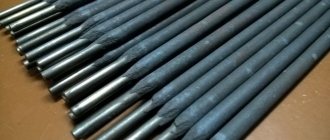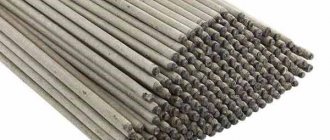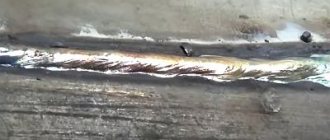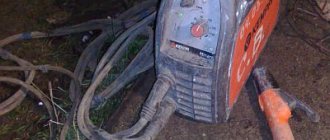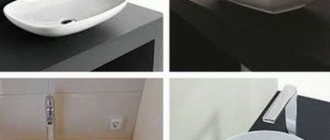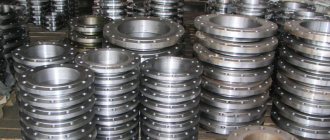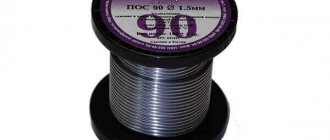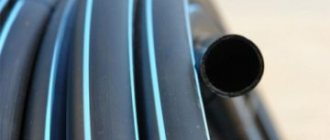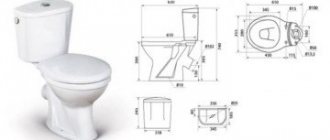Features of cast iron welding
It is immediately necessary to make a reservation that not all cast iron can be welded. The fact is that this metal consists of an alloy of iron and carbon. And the latter contains as much as 2.14%. It is this circumstance that prevents a high-quality connection.
All cast iron is divided into white and gray. The first one has a white color visible on the fracture. And the carbon in it is metastable and appears in the form of cementite. This circumstance is decisive in relation to the processing of this metal. Welding is completely impossible. And due to increased fragility, only grinding is allowed.
A silver tint appears at a fracture in gray cast iron. The carbon in it has passed into a stable phase and appears in the form of graphite. And this condition allows welding work to be carried out. It remains to decide what to cook cast iron with and how.
Iron with a large amount of stable carbon in the form of graphite can and even should be welded. After all, it is necessary to repair cast iron parts that have developed defects. But the characteristics of the metal are so specific that serious difficulties cannot be avoided when working with it.
Welding process Source svarkaspec.ru
Here is a list of what you may encounter when welding cast iron:
- If cast iron cools too quickly during operation, its surface turns from gray to white. With all the ensuing consequences.
- If the temperature regime is chosen incorrectly, cracks appear in the weld area due to overheating of the alloy.
- If you do not fight the active release of gas, the seam will become covered with pores.
- The formation of a seam is hampered by the high fluidity of cast iron.
- If silicon is allowed to oxidize in the welding zone, it will result in unwelded areas.
But taking into account all the difficulties, technologies have been developed that make it possible to obtain extremely high-quality seams on the surface of cast iron. You just need to choose the right method of influencing the metal. And also carry out preliminary preparation and adhere to all the nuances of the technique.
German electrodes
Germany produces high-quality cast iron electrodes, which are widely used in Russia. For example, this includes the UTP 86 FN brand and the UTP A68 HH stainless steel filler rod. The German company UTP Schweissmaterial makes nickel electrodes that are suitable for welding with cast iron. The welder will make high-quality and crack-resistant seams.
Capilla 41 - electrodes from another German company, with the help of which work is carried out on hot welding technology. If the cold method is chosen, then it is better to purchase Capilla 43.
Manufacturers also took care of people who are interested in which electrode to cook cast iron and steel. Experts advise buying carbon products from TEAM BINZEL, as they produce consumables that can be used to work with many types of metals (for example, copper and stainless steel).
Methods of welding cast iron
To obtain a good seam, cast iron is treated in two ways. There is such a thing as hot welding. To do this, you need to heat the metal to 650 °C. This temperature regime allows you to avoid the appearance of cracks in the seam area.
Hot welding of cast iron structure Source stellastroy.ru
But such temperatures can only be obtained in industrial workshops. Therefore, semi-hot welding is used at home. And cast iron is heated only to plus 350 °C. In both cases, it is necessary to ensure that the temperature of the seam and the rest of the surface rises evenly. And the biggest problems are related to proper cooling of the metal.
But all home craftsmen practice the second method, which is called cold welding. There is no need to heat the workpiece for it. And all the work is done only with special electrodes. But this is not enough for a high-quality seam. First you need to properly prepare the surface, and when welding, strictly adhere to the technological map.
Preparation
The future welding site is thoroughly cleaned. To do this, it is better to take a grinder with a petal wheel. In this case, you need to ensure that all edges do not have sharp corners. The working surface should only have a spherical shape.
Next, you need to degrease. Any gasoline or solvent will do for this. The main thing is to ensure complete neutralization of the oxidized metal.
Separately, it is necessary to say about the stiletto heels. They are supporting elements and are often used to create a high-quality connection. For example, if you need to weld a crack on the surface of a cast iron part, then after cleaning, holes are drilled at its ends. Steel pins are inserted into them.
The size of the element has strict regulations. Its diameter cannot be more than 40% of the thickness of the cast iron surface. The pin should protrude above the plane no more than 4-6 mm. And their number is limited by the size of the crack. After all, the distance between two studs should not exceed six of their diameters.
Welding cast iron on studs Source cf2.ppt-online.org
After preparing the surface, before welding cast iron, attention is paid to the selection of electrodes. Conventional ones (for steel) will make an even larger hole. Therefore, only those that have the correct coating are needed, allowing them to act on the delicate cast iron in the right way.
Electrodes containing copper, chromium or nickel are suitable. And the most common of them: TsCh-4, OZCh-2, OZZHN-1 and MNCh-2. Moreover, you need to ensure that their diameter does not deviate from 3 mm.
Popular electrodes
Some consumables for welding work have already been mentioned above. The main brands of electrodes for cast iron include the following:
- OZCh-4;
- OZZHN-1;
- TsCh-4;
- OK 92.18;
- OZCH-2.
What electrode is used to weld cast iron to metal? From the mentioned list, consumables of the TsCh-4 brand are used for these purposes.
Welding process
Once all the supplies have been purchased, it will be helpful to read the instructions on the packages. Useful information is provided there. From the mode of use to the required number of electrodes for a certain seam size.
And for cold welding at home there are basic rules:
- Reverse connection polarity is selected.
- The welding machine is set to minimum power.
- There is no need to make a continuous seam longer than 5 cm.
- To prevent the metal from overheating, breaks in work are taken as often as possible.
- The first layer, as well as the last one, must be forged with a hammer, but with the slightest force.
Let's look at how to cook cast iron using specific examples.
Cold welding of cast iron with an electrode Source pp.userapi.com
By stiletto heels
The studs are installed in the prepared holes. Using an electrode, layer by layer, metal is welded around each auxiliary element. At the end, the end of the pin is completely covered with fusion.
To ensure that the surface temperature does not exceed 80 °C, breaks are taken. It’s better to combine them with transitions between hairpins. After working on one for a while, they leave it for a while and move on to the next one. So they move in a circle with short pauses.
When all the studs are hidden under the flashings, the final seam is made. It connects all the welded metal together.
Multilayer
The chamfers are checked. They should be spherical in shape, without sharp protrusions. Moving from one edge to the other, the first seam is fused. While it is still hot, it is hammered into the lungs. Then it is allowed to cool.
If possible, the part is turned over to the other side. A similar layer of metal is applied to the rear, which is also forged. The part returns to its original position, and now, layer by layer, the entire defect is covered with fusions. Remembering to lightly hammer each welded seam, and also take breaks so as not to overheat the metal.
How to brew cast iron correctly
The special properties of the metal cause increased demands on the welding process. The right approach requires careful preparation. The work area must be well cleaned of any contamination. Used: grinder, metal brushes, sandpaper. Oil stains are removed with solvents. For severe contamination, use torches or sandblasting.
Interesting: Main types of metal welding
A common occurrence is cracks on the surface along the edges of cast iron products. Their sealing requires a special approach. The cracks are cut and cleaned to their full length to ensure complete filling with the melt. If necessary, the workpieces are drilled along the edges, and the ends are cut at the angle required for welding.
Cast iron can be brewed in several ways, and it is important to choose the right option.
Welding technology and methods
There are 3 main methods of welding cast iron, depending on preheating:
- Hot method. Before welding, parts are heated to 600-680 °C, which increases the plasticity of the metal and reduces the risk of cracking. This technique is ideal for production environments where special ovens are available. It is extremely difficult and dangerous to provide such heating in a house.
- Semi-hot technology. The metal is preheated to 320-360 °C. Heating is done with special hair dryers. It is difficult to implement this method at home, but if you have a separate workshop, you can carry out the process.
- Cold welding. This is the most common technique for working at home. Preheating is not performed or does not exceed 60–80 °C. With this method, you will have to take into account all the difficulties of working with cast iron.
When choosing a method, you must take into account safety, the type of metal and the availability of the necessary equipment.
Features of welding at home with an inverter
For electric welding at home, you can use a regular inverter or a special home semi-automatic machine. The most common method is cold welding with electrodes, when an inverter is used as a current source. When connecting the device, the polarity is reversed. It is turned on at the minimum power for this type of electrode. Welding is done with short seams 40–50 mm long.
There are 2 ways to ensure the strength of the weld:
- Welding with studs. As a rule, steel studs with a diameter of up to 0.4 times the thickness of the cast iron workpiece are used. They are inserted into holes drilled along the edges. Their projection does not exceed 4–5 mm, and the installation pitch is up to 5 diameters. At the initial stage, the protruding part is scalded around, and the melt fills the seam. Then, the metal is welded from stud to stud, forming a circular weld. Gradually, the entire surface at the joint should be evenly filled with the deposited metal.
- Multilayer welding. After careful preparation of the edges of the workpieces and the formation of chamfers, the parts are joined and the layer-by-layer formation of the weld begins. After applying the first layer, it is carefully forged with a hammer. Then, the procedure is repeated with the second layer, etc. If flat workpieces are to be cooked, then after applying each layer, the parts are turned over and the layer is applied on the reverse side.
Reference! When welding, it is important to remember that the metal cannot be overheated, and therefore frequent stops of the process are necessary.
Briefly about the main thing
If a crack appears on a cast iron part, and you have access to an inverter at home, then you can consider that one third of the job is done. All that remains is to choose the right electrodes and choose one of the repair methods.
Whether the seam is applied to the studs or fused layer by layer does not make a significant difference. The main thing is to strictly follow the technology and prevent the metal from overheating. And if all the conditions are met, then home repairs will be in no way inferior to those done in the workshop.
Ratings 0
